|
|
Post by tufta on May 24, 2009 21:51:06 GMT 1
20 Years of Freedom: Let Brussels Continue Its Historical Studies (sic, sic, sic!)
[/b]
Dominik Uhlig
We thank the European Commission for introducing numerous changes to the 20 Years of Freedom video following Gazeta's intervention. It is much better than it was. The students dressed up as riot police and a Gazeta Polska demonstration pretending to be Solidarity are gone. But our criticism does not end here.
First a small thing. The images from Poland carry the caption 'Poland 1981', but in reality the pacification by the ZOMO riot police of a demonstration at Warsaw's Plac Zamkowy took place later.
The video's fundamental message remains unchanged - Europe's freedom began with the fall of the Berlin Wall and Europe celebrates the 20th anniversary of the end of communism again under the Brandenburg Gate.
The film's authors did not find room in it for John Paul II, whose 'let your Spirit descend and renew the face of this earth' offered hope and inspiration to millions of Poles and Europeans. There is no image of Lech Wałęsa signing the 1981 August Agreements with his absurdly big ball pen. Not a word about the 4 June 1989 elections in Poland, the first (semi) democratic ballot behind the Iron Curtain after the war. The Berlin Wall collapsed a long half year later.
We encourage the Commission to continue its historical studies.
It is also great that the video's 'correction' has so many mothers and fathers. Among those who have publicly taken credit for it are the Foreign Ministry, the European Integration Committee Office (UKIE), the European Commission's representation in Poland, and Polish commissioner Danuta Hübner.
It is a pity that they had not noticed the video before we wrote about it. It was available online for several days and Europeans were free to view it.
Gazeta Wyborcza
|
|
|
|
Post by Bonobo on May 24, 2009 23:57:17 GMT 1
The film's authors did not find room in it for John Paul II, whose 'let your Spirit descend and renew the face of this earth' offered hope and inspiration to millions of Poles and Europeans. There is no image of Lech Wałęsa signing the 1981 August Agreements with his absurdly big ball pen. Not a word about the 4 June 1989 elections in Poland, the first (semi) democratic ballot behind the Iron Curtain after the war. The Berlin Wall collapsed a long half year later. The Pope hasn`t been mentioned because religious topics aren`t popular in secular Europe any more.  As for Lech Walesa, he wasn`t mentioned because Poles successfully destroyed his image themselves, accusing him of being a communist agent. And it doesn`t matter that the accusers, moral dwarfs, were his political enemies. The word spread and caused the damage. |
|
|
|
Post by Bonobo on May 29, 2009 19:05:23 GMT 1
Gary Cooper back in town
27.05.2009 09:11
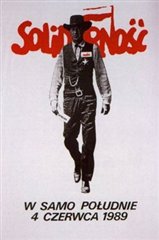
THe origical 1989 poster
Twenty years after the June 1989 elections, Gary Cooper posters remind of Solidarity's historic victory.
A poster featuring an image of Gary Cooper from the famous movie High Noon was displayed in Warsaw in June 1989 on the eve of Election Day. Designed by Tomasz Sarnecki, it depicted the actor carrying not a gun, but a voting ballot, and wearing a Solidarity logo above his sheriff's badge, which read: `It's high noon, June 4, 1989.'
At a time when Poles celebrate the anniversary of Solidarity's landslide victory, a huge poster, measuring 36 by 33 metres, modelled on the 1989 poster has been displayed on the eastern side of the Palace of Culture, ironically, Stalin's gift to Poland in the 1950s. From it, a gigantic figure of a man bearing a striking resemblance to Gary Cooper, passing by the former Communist Party headquarters, looks at the city. He is sporting a moustache, too, very much like Lech Walesa.
"It shows that communism has been defeated in Poland once and for all," says poster designer Marcin Mroszczak of his work.
Krystyna Ratajczak, in charge of PR at the Warsaw City Council, says that by displaying the poster at the very heart of the capital, Poland sends a spectacular message to the world that Warsaw was the centre of the democratic transformations in the whole of Central and Eastern Europe.
Gary Cooper also reminds the residents of Berlin of the 1989 Polish elections. A huge banner, measuring 66 by 17 metres, featuring a motif from the historic poster has been displayed on the building of the former Polish Embassy in the German city. A copy of the poster is one of the items at an exhibition The end of communism held at the Polish Institute in Berlin. The original design of the poster was presented to the US Library of Congress by the late Polish Foreign Minister Bronislaw Geremek in 1999.
In 1989, the poster was printed in France, thanks to financial support from French trade unions. Some 10, 000 copies arrived in Warsaw by air on the night preceding the parliamentary elections. Before polling stations opened, most of the copies were plastered on kiosks and walls in and around Warsaw.
|
|
|
|
Post by Bonobo on Jun 6, 2009 22:43:36 GMT 1
Twenty years ago, on 4 June, 1989, partly free elections took place in communist Poland as a result of talks of a Round Table between the regime and part of the opposition. The society treated the elections as a plebiscite and simply rejected the Communist system. Soon, further changes occurred. In August, Tadeusz Mazowiecki became the first non-Communist Prime Minister. Events in Poland were the beginning of the fall of the Communist system in the whole of East-Central Europe. Already in June, negotiations between the authorities and the opposition in Hungary began. The abolishment of fortifications on the border with Austria meant the end of the “Iron Curtain”. On 23 August, 1989, on the fiftieth anniversary of the Ribbentrop-Molotov Pact, hundreds of thousands of Estonians, Lithuanians and Latvians created a living chain and manifested their desire for independence. In October, the “peaceful revolution” broke out in the German Democratic Republic and on 9 November, the Berlin Wall fell down. Shortly after that, the “Velvet Revolution” broke out in Czechoslovakia and also reforms in Bulgaria started. At the end of December, Ceauşescu’s dictatorship in Romania was overthrown; however, over one thousand people died during the revolution. In 1990, in most of the countries of East-Central Europe, free elections took place. Lithuania, Latvia and Estonia proclaimed independence, which Soviets tried to crush with force at the beginning of 1991. It was, however the end of the Soviet Union. After an unsuccessful putsch of conservative forces in August 1991, at the end of the year the leaders of Russia, Ukraine and Belarus proclaimed the dissolution of the USSR. In the same year, the dictatorship in Albania came to grief, the last Communist dictatorship in Europe. The Warsaw Pact and the Council for Mutual Economic Assistance were dissolved. Read more about this fascinating period of modern history www.year1989.pl/Yesterday Poles celebrated the 20th anniversary of the collapse of communism in their country. There were concerts, events, festivals. Also, a special golden plane flew to Brussels with an unusual crew. Golden aliens` invasion officially started the festival which is called: It all began in Poland.     4 June 1989. en.wikipedia.org/wiki/Contract_Sejm
Contract Sejm (Polish: Sejm kontraktowy) is a term commonly applied to the Polish Parliament elected in the Polish parliamentary elections of 1989. The contract refers to an agreement reached by the Communist Party and the Solidarity (Solidarność in Polish) movement during the Polish Round Table Agreement. The final agreement was signed on April 5, 1989. As a result, real political power was vested in a newly created bicameral legislature and in a president who would be the chief executive. Solidarność became a legitimate and legal political party.
Perhaps the most important decision reached during the talks was to allow for partially-free elections to be held in Poland. All seats to the newly-created Senate of Poland were to be elected democratically, as were 161 seats (35 percent of the total) in Sejm. The remaining 65% of the seats were reserved for the Communist Party and its satellite parties. In addition, all 35 seats elected via the country-wide list were reserved for the Party's candidates provided they gained a certain quota of support. This was to ensure that the most notable leaders of the Party were elected.
The outcome of the election was largely unpredictable. After all, Poland had not had a truly fair election since the 1920s, so there was little precedent to go by. It was clear that the Communists were unpopular, but there were no hard numbers as to how low support for them would actually fall. The Communist government still had control over most major media outlets and employed sports and television celebrities for candidates, as well as successful local personalities and businesspeople. Some members of the opposition were worried that such tactics would gain enough votes from the less educated segment of the population to give the Communists the legitimacy that they craved.
The election of June 4, 1989 (and the second round of June 18) brought a landslide victory to Solidarność: 99% of all the seats in the Senate and 35% of all possible seats in Sejm. Out of 100 seats in the Senate, 99 were won by Solidarity and 1 by an independent candidate. Out of 35 seats of the country-wide list, only one was gained by the Party candidate (Adam Zieliński) and one by a ZSL satellite party candidate, while the remainder were taken by the Solidarity in the second run. Altogether, out of 161 seats eligible, Solidarity took 160.
The turnout was surprisingly low: only 62.7% in the first round and 25% in the second. The outcome was a major surprise to both the Party and Solidarity. Only a few days before June 4 the party Central Committee was discussing the possible reaction of the Western world should Solidarity not win a single seat. At the same time the Solidarity leaders were trying to prepare some set of rules for the non-party MPs in a Communist-dominated parliament, as it was expected that the Solidarity would win not more than 20 seats.
Although the elections were not entirely democratic, they paved the way for creation of Tadeusz Mazowiecki's cabinet and a peaceful transition to democracy, which was confirmed after the Polish parliamentary elections of 1991.
Elections  All Solidarity candidates had a photo with Lech Walesa taken.  Famous posters 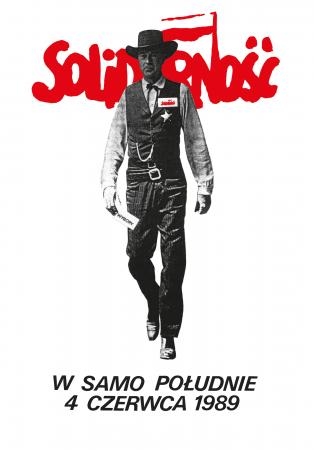   Known celebrities took part in Soldiarity campaign Jane Fonda       Rally  Sticking posters         We must win   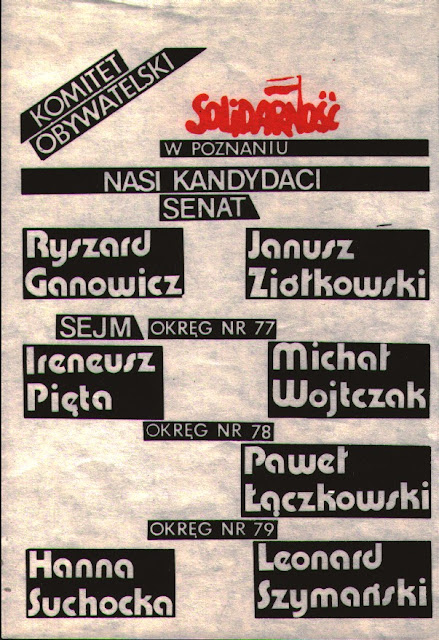  Voting    Checking results  Solidarnośc office in a cafe.  Victory   On the same day, Chinese communist dictators ordered the army to massacre revolted students in Tiananmen Square.      PS. Naturally, I took part in voting. The week before had been very busy, I helped sticking posters all over the area. Then, on the election day, I had a terrific satisfaction crossing out communist candidates, those red stinking bitches. Serves them well!!!! ;D ;D The country-wide list comprising the most hardened communists. They were all turned down except for one. 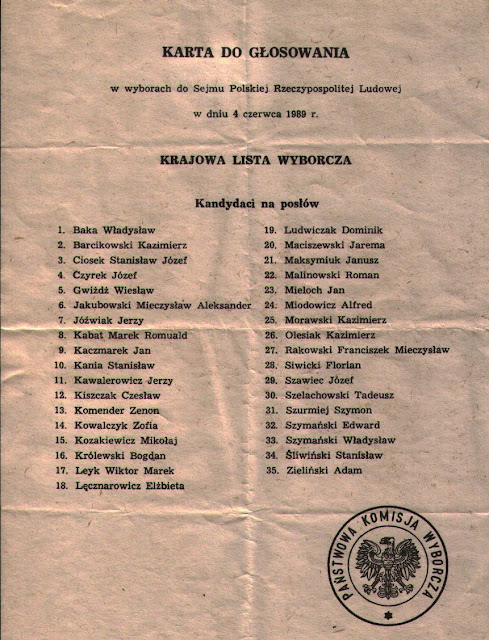 Today commemoration A giant poster on Warsaw skyscraper 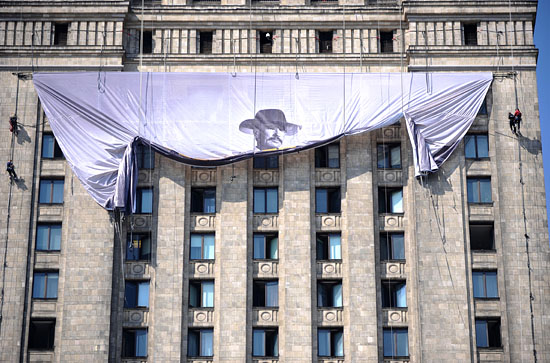   Memorial stone in a Polish town  |
|
|
|
Post by Bonobo on Jun 7, 2009 8:28:54 GMT 1
Thursday, June 4, 2009
Tearing down the Iron Curtain
By MICHAEL MEYER
PRAGUE — A quiz for history buffs. Twenty years ago — on June 4, 1989 — three events shaped a fateful year. Which do you remember most vividly, and which most changed the world?: (a) the bloody denouement of the protests on Tiananmen Square; (b) the death of Iran's revolutionary cleric, Ayatollah Ruholla Khomeini; and (c) the Polish elections.
Few would answer (c). The victory of the famed opposition trade-union movement, Solidarity, in Eastern Europe's first free election since 1946 was eclipsed by the violent crackdown in Beijing and Khomeini's tumultuous passing. Yet no single event did more to bring down communism in Europe — and thus to reshape the postwar international order.
The next few months will bring all sorts of commemorations of communism's end, particularly of the fall of the Berlin Wall in November 1989. To many, it was a glorious moment, emblematic of the West's victory in the Cold War, and one that seemed to come out of the blue. But if you watched the Eastern Bloc's disintegration from the ground, you would know that the process was far longer and more complex than most people realize.
The Polish election was a point of no return, the moment when forces for change became irreversible. They gathered momentum after a summer of labor strikes, when Poland's communist chief, Gen. Wojciech Jaruzelski, concluded that the country's economic troubles were too grim to face alone. Why not enlist the help of Poland's opposition, he reasoned, if not to solve the problems, then at least to share the blame for them?
And so, after six months of bargaining, a historic deal was struck. Poland would hold free and fair parliamentary elections, and Solidarity would compete. It never occurred to the ruling communists (or to Solidarity) that they might lose. Never in their wildest dreams did they imagine being driven from power altogether. Yet that is what happened.
In retrospect, it is astonishing that there should have been any doubt. Solidarity's campaign was all chutzpah. An iconic campaign poster captured the public mood: a picture of a gunslinging Gary Cooper as the sheriff in the classic western "High Noon."
June 4 was the day of reckoning in Dodge City East. On that bright Sunday morning, as spring turned to summer, voters wasted little time in dispatching Poland's communists to the abattoir.
On their dying day, Poland's communists managed one last perversity, an unwitting act of utter self-humiliation. They devised an electoral system whereby Poles would not vote for candidates of their choice, but would cross out those they did not want — which is to say, each and every communist.
Everywhere you looked, people were excising hated autocrats. Here, at long last, was Poland's long-awaited popular uprising, revenge for December 1980, when Jaruzelski declared martial law, banned Solidarity, and threw its leaders in jail. Revolution by deletion! The pen, at last mightier than the sword, became a weapon of glorious retribution, wielded with style. Some voters slashed their ballots boldly, decapitating the old regime with flourishing strokes. Others savored the moment, perhaps puffing a cigarette as they reveled in this or that deletion. "Oh yes, he jailed my cousin." Pfft! "Oh, that sponging apparatchik, living high on our penury." Pfft! Pfft!
By contrast, the communists' campaign was all but invisible. In all of Warsaw, only a couple government candidates bothered to put up posters. Most counted on the party's media monopoly to carry their message, such as it was: "Vote Lezek, a good communist."
To their credit, the regime accepted its inevitable loss with remarkable grace. At 3 p.m. on the day after the vote, Jaruzelski summoned top party officials. "Our defeat is total," he told them. "A political solution will have to be found." By that, he meant no violence and no doctoring the ballot count. The communists would live with the result.
Twenty years later, I remain mystified. Those of us covering Eastern Europe knew that Solidarity would win. We knew, too, that its peaceful victory would be a lesson for the rest of the bloc. For anticommunists everywhere, the Polish election was extraordinarily encouraging. Thanks to Poland, what only days before had seemed impossible was, suddenly, possible.
There were other signs. In May, Hungarian reformers began tearing down the fence along their border with Austria — a hole in the Iron Curtain. In Moscow, Mikhail Gorbachev spoke of a "Common European House" and repudiated the interventionist Brezhnev Doctrine.
Yet when the Berlin Wall tumbled down, experts and world leaders alike were unanimous. "We never saw it coming," they confessed. The Cold War had lasted so long that change seemed unimaginable until freedom burst forth.search.japantimes.co.jp/cgi-bin/eo20090604a1.html
|
|
|
|
Post by Bonobo on Jun 20, 2009 19:59:11 GMT 1
I have finished the main presentation of Polish anti-communist past from 1945 to 1989. I just added a post about 1988 strikes which were very important as they directly led to the Round Table talks and recognition of Solidarity by the communist regime. To keep the chronological order of events, the addition is here: polandsite.proboards.com/index.cgi?board=polishhistory&action=display&thread=70&page=5#11411Now, with the general story completed, I am going to look into interesting details of the anti-communist resistance. Priest Tadeusz Isakowicz- Zalewski. Twice beaten by communist services in 1985 but never gave up his underground work. A mass in a striking steel plant in Krakow.   He actively supported Solidarity.  en.wikipedia.org/wiki/Tadeusz_Isakowicz-ZaleskiTadeusz Isakowicz-Zaleski (Armenian: Թադևոս Վարդապետ Իսահակյան-Զալեսկին, in Latin script: Tadevos Vartapet Isahakian-Zaleski) is a Polish Roman-Catholic and Armenian-Catholic priest of Armenian descent. Born September 7, 1956, in Kraków, Isakowicz-Zaleski was an activist of the anticommunist student opposition[1], now he is a vivid supporter of the lustration of the Polish Church. He wrote a controversial book on priests who cooperated with communist secret services. en.wikipedia.org/wiki/Tadeusz_Isakowicz-ZaleskiTadeusz Isakowicz-Zaleski (Armenian: Թադևոս Վարդապետ Իսահակյան-Զալեսկին, in Latin script: Tadevos Vartapet Isahakian-Zaleski) is a Polish Roman-Catholic and Armenian-Catholic priest of Armenian descent. Born September 7, 1956, in Kraków, Isakowicz-Zaleski was an activist of the anticommunist student opposition[1], now he is a vivid supporter of the lustration of the Polish Church. He wrote a controversial book on priests who cooperated with communist secret services.
Father Isakowicz-Zaleski was born in Krakow to a Polish father and an Armenian mother[3]. Since high school years he was engaged in several Roman-Catholic youth organizations. After graduating, he entered a Seminary in his native city, which did not prevent him from being called for service in the Polish Army. He served in the years 1975-1977 in Brzeg[3]. In the late 1970s, after returning to the seminary, he joined the anticommunist student movements, such as Student Committee of Solidarity. He co-published a Samizdat magazine Cross of Nowa Huta, also in 1977 he debuted in Tygodnik Powszechny with his poems.
In 1980, Isakowicz-Zaleski became engaged in the Solidarity movement[1]; three years later he was ordained and ordered to continue studies at the Papal Armenian Collegium in Rome. Unfortunately, he was not allowed to leave Communist Poland, because of his underground activities. Isakowicz-Zaleski began working in Krakow’s district of Nowa Huta, where he celebrated holy Mass for the workers and for the fatherland in the Maximilian Kolbe parish in Mistrzejowice. Throughout the 1980s, he was repressed, and the Communist secret service agents twice brutally beat him[4][1]. Both incidents happened in 1985, in April and in December[5] and Isakowicz-Zaleski’s ordeal was later used by Polish director Maciej Gawlikowski, in his 2006 film To Intimidate the Priest. In one incident, the agents burned his chest with a cigarette[6].
In 1988, as a priest of the workers, he participated in the strike in Nowa Huta’s Lenin Steel Mill. At the same time, he began helping the poor and the handicapped, together with nuns from local convents. In 1987, he co-founded charitable Foundation of Brother Albert Chmielowski. Currently, he is director of the Foundation, which owns a shelter in the village of Radwanowice in the suburbs of Krakow.
On May 3, 2006, father Zaleski was awarded the Polonia Restituta by President Lech Kaczynski.
 |
|
|
|
Post by Bonobo on Jun 22, 2009 9:40:17 GMT 1
The story of Lenin Monument in Nowa Huta, Kraków. Monuments are something different. They are man-made to represent some ideal, etc.....I say ditch the communist monuments unless they have some incredible artistic value, which I very much doubt! Bombastic Lenin monument erected in Nowa Huta in 1973 was pulled down in 1989 after violent demonstrations during which people tried to destroy it with steel ropes and finally burned it. The police, sent by Solidarity government, protected the monument in fear of Russian Embassy`s reaction ands clashed with demonstrators. To avoid further violence, the monument was removed on 10.12.1989, 3 days before the anniversary of martial law. Earlier, there were more attempts to assassinate Lenin. In 1979, a worker from the nearby Lenin Steel Plant, Andrzej Szewczuwaniec, tried to blow it up with his friends at night. Amateur assassins blew up the job. Lenin only lost his foot, the police didn`t find the perpetrators though the investigation was massive, including students of chemical classes in Krakow high schools. In 1980s, during the martial law, there were also demonstrations of angry protesters near Lenin monument. Unveiling     The best of times      Prevention    See the communist police guard Lenin monument Burning Lenin    Lenin was actually hanged. 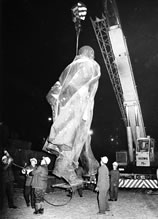  Ditched Lenin  Today it is in the museum in Sweden.  Empty space in Nowa Huta  www1.dziennik.krakow.pl/ipn/nowa_huta_miasto_pracy_i_walki/ www1.dziennik.krakow.pl/ipn/nowa_huta_miasto_pracy_i_walki/Couldn`t they leave Lenin, painted in bright colours, with a baseball cap, and a f*g in his mouth?? Today it would be an unusual attraction in Nowa Huta. Poles are too emotional. They can`t get rid of historical prejudice. ;D ;D ;D ;D ;D |
|
|
|
Post by Bonobo on Jun 22, 2009 10:11:22 GMT 1
Nowa Huta district in Krakow, built as a perfect socialist town, paradoxically, was a witness to many fights against communist rulers. In the 1980s Nowa Huta became a gathering place of many demonstrations and violent street fights of the Solidarity movement, as thousands of steelworks workers were involved in them. As a result, the town was brought to world attention. The first fights started as early as in 1960 and were connected with the cross and the church.
Nowa Huta was built without a church and many of the early struggles in the town were focused around calls for the construction of a church in the town. These struggles testified to
the growing intertwining of the life of the community and the life of the workplace, and wider labour politics. The people of Nowa Huta first erected a wooden cross in the heart of the town 1957 and replaced this with a steel cross on April 27 1960. The regime’s response to this was heavy-handed and struggles for the cross became closely linked with broader opposition to the regime. The construction of a steel cross in a steel community is symbolic enough, but the ‘consecration’ of this cross in April 1960 was accompanied by the singing of both religious hymns and the Internationale. It is clear that the religious and class identity of the people of Nowa Huta was merging, that the church, previously a site of rural conservatism, was becoming associated with quite radical, worker-based activities.
en.wikipedia.org/wiki/Nowa_Huta
One type of building lacking from the original urban design of Nowa Huta was a Roman-Catholic church, and a campaign to construct it lasted several years. As early as in 1960, inhabitants of Nowa Huta began fighting for permit to build a church. In that year, violent street fights erupted over a wooden cross, erected by the locals, who were supported by Bishop Karol Wojtyla. Finally, in 1966, a church called Lord's Arc was built.Initially, communist authorities in Krakow allowed to build a church. !950s, the consecration of a cross in the site of a future church  Later they changed their mind. A leaflet protesting against plans to build a school on the site. We will fight better than Hungary against Russia! Finally, after local community and parish refused to remove the cross, the authorities sent a construction team to take it down. Upon hearing the news, believers decided to resist actively. People gather to defend the cross.    Near the cross       There were regular fights in the street for a few days. About 3000 people defended the cross. The police used clubs, water cannons, tear gas, even guns. Believers shouted: For faith, for motherland!! The demonstrators attacked the local council building where they burnt documents. They also threw stones at the police. Burnt documents  About 500 protesters were arrested, 87 sentenced to prison, many fired from work. 181 policemen were injured. krakow.naszemiasto.pl/wydarzenia/470511.htmlMedical info from a hospital about a shot wound of a chest.  The policeman`s report about using his gun during clashes.  Burnt police car.  www1.dziennik.krakow.pl/ipn/nowa_huta_miasto_pracy_i_walki/ www1.dziennik.krakow.pl/ipn/nowa_huta_miasto_pracy_i_walki/ |
|
|
|
Post by Bonobo on Jun 25, 2009 18:38:05 GMT 1
Poles to unveil Solidarity monument outside German parliament
By DPA
Jun 16, 2009
Warsaw - Polish parliamentarians will begin a two-day visit to Berlin Tuesday, which will see them unveil a monument to Solidarity, the shipbuilders' union which helped topple communism, in front of the German parliament.
Solidarity helped bring Poland partly-free elections in 1989 and lead to changes across the Soviet bloc that later brought down the Iron Curtain.
German Chancellor Angela Merkel and President Hoerst Keller will take part in the unveiling, Polish Radio said.
The monument contains a piece of a wall from the Gdansk shipyard where Walesa held massive protests in the 1980s. The fragment is meant as a reminder of Solidarity's role in toppling the Berlin Wall and uniting Germany.
Polish officials were also invited to events commemorating the 1953 uprising in then East Germany. The uprising by construction workers on June 17 was brutally suppressed after an intervention of Soviet troops. Apart from Lenin, a few other comunist monuments were toppled Dzierżyński: 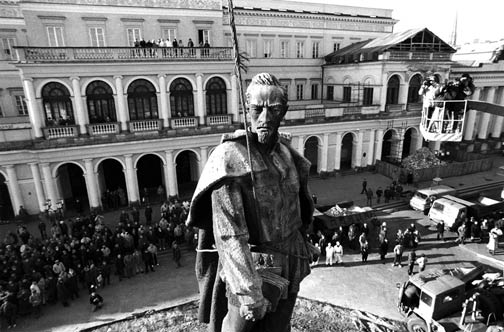 Defenders of Socialism 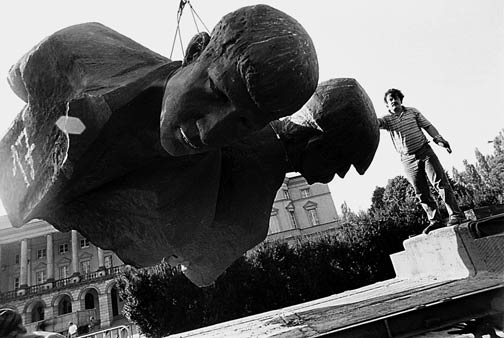
|
|
|
|
Post by Bonobo on Sept 24, 2009 21:36:45 GMT 1
Cabinet of Tadeusz Mazowiecki, a Solidarity leader, opposition activist, was sworn to office on 12 September 1989. The government comprised both opposition and communist party members. Communists were still too strong to ignore them.
During his first parliamentary speech as Prime Minister, Mazowiecki fainted. However, it was not to be an omen of things to come. Mazowiecki's government managed to carry out many fundamental reforms in a short period. The political system was thoroughly changed; a full range of civil freedoms as well as a multi-party system were introduced and the country's emblem and name were changed (from the People's Republic of Poland to the Republic of Poland). On December 29, 1989, the fundamental changes in the Polish Constitution were made. By virtue of these changes, the preamble was deleted, the chapters concerning political and economic forms of government were changed, the chapters concerning trade unions were rewritten and a uniform notion of possession was introduced. Thanks to these changes, the economic transformation was enabled. The set of reforms originating under Mazowiecki's government (named after its creator – Balcerowicz's plan) enabled the destruction of hyperinflation, changes in the economy and the introduction of free market mechanisms and privatization..  Mazowiecki gestures triumphantly after the election of his cabinet on September 12, 1989.  There`s govenrment! The other Poland comes to power.  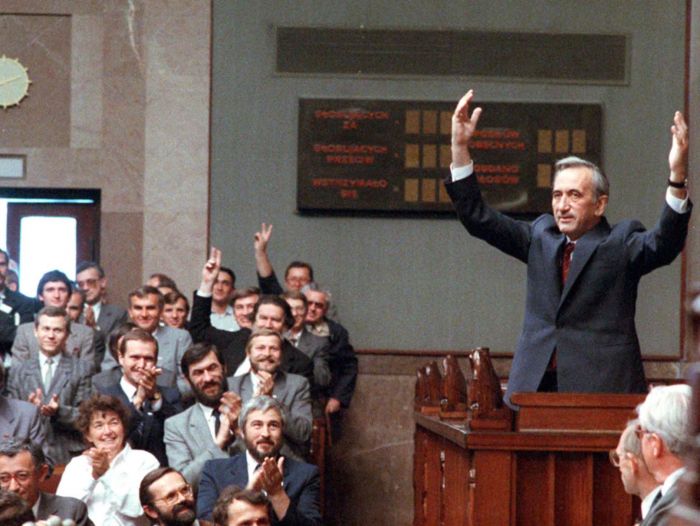 Poland and Germany - conciliation. 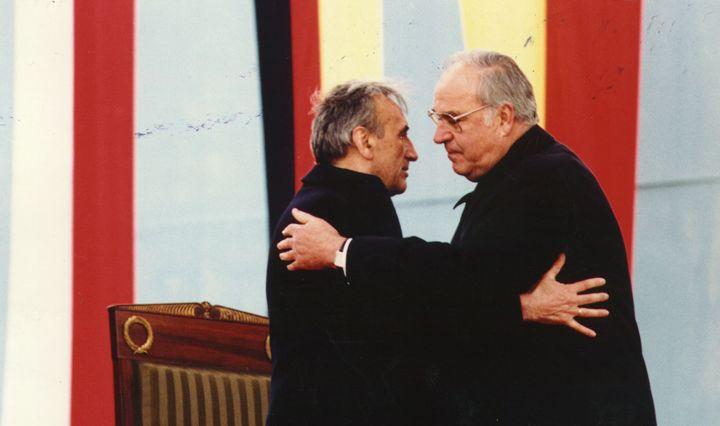 A few days ago the 20th anniversary was celebrated. Parliament paid a tribute to old Mazowiecki.   What are the results of the change of the system? Multiple. But most important is the fact that in 1989 Poland`s GNP equaled 30% of European Union`s. Today it is 55% and still growing. GDP per capita came to about $6,000 in 1989 and now is above $17,000, Poland is the only country in Europe which is going to enjoy an economic growth this year:  |
|
|
|
Post by Bonobo on Oct 22, 2009 23:10:34 GMT 1
Charges brought against Popieluszko' s persecutor
thenews.pl
19.10.2009
Prosecutors at the Polish Institute of Remembrance have brought charges against a former functionary of the communist security service who harassed the late Fr. Jerzy Popieluszko, by faking evidence to accuse him of crimes.
The suspect carried out activities meant to eliminate Fr. Popieluszko from his work as chaplain of the Solidarity freedom movement by planting evidence incriminating the priest in his flat, to prompt an arrest for the possession of weapons.
"The activities of this functionary allow for charges to be brought against him. This is a communist crime, for which he can face 5 years of prison," explains Andrzej Arseniuk, spokesman for the Institute of National Remembrance.
Pawel Wypych, of the presidential chancellery, is of the opinion that the persecution and murder of Fr. Popieluszko needs to be further explained, in order to shed more light not only on direct culprits, but those who commissioned the crimes against the priest and got away with it.
"Poles deserve to know who was behind Fr. Jerzy's murder. It would be good if these people eventually faced justice. I think 25 years has been a very long time, especially since Poland has been independent for 20 years now. We can ask the question: what happened in early 1990s and why these cases were not fully explained," Wypych stated.
Father Popieluszko was murdered by the Communist secret police on 19 October 1984 and Poland is commemorating the 25th anniversary of the tragic event with two days of observances, including film showings and a commemorative run.
|
|
|
|
Post by Bonobo on Nov 15, 2009 22:28:11 GMT 1
Polish court orders retrial in martial law deaths
Associated Press
2009-10-29
An appeals court in Poland has ordered a third retrial of a communist-era interior minister over the 1981 killing of nine protesting miners by riot police.
The Warsaw Appeals Court on Thursday overturned a verdict which said that now retired Gen. Czeslaw Kiszczak inadvertently contributed to the deaths and that the statute of limitation had run out. Prosecutors appealed that verdict.
The appeals court said the judges did not analyze the circumstances well enough and returned the case to a lower court.
If the case goes to trial, it will be the fourth time that Kiszczak, 84, has faced a judge. He has denied any responsibility for the shooting deaths at the Wujek coal mine.  
|
|
|
|
Post by Bonobo on Dec 18, 2009 23:49:39 GMT 1
1970 Gdynia massacre anniversary
17.12.2009 16:18
On 17 December, 1970, in Gdynia, communist militia and army opened fire at protesting workers in Gdynia, northern Poland, killing 18 people.
Following yesterday's 28th anniversary of the massacre at the Wujek coal mine, where communist militia opened fire at striking workers, killing 9 and injuring many more, today Poland marks the 39th anniversary of another massacre orchestrated by Poland's communist regime.
It is estimated that in December of 1970 at least 44 people were killed in Gdansk and Gdynia and thousands wounded by communist militia crushing workers' protests. Some sources suggest as many as several hundred might have lost their lives.
Because information was strictly censored, exact numbers of casualties remains a unknown. Communist authorities forged death certificates and families of victims were forced to bury their dead at night, with communist militia guarding them so that nobody found out what happened.
"My son was killed in Gdansk. We arrived at the cemetery at night, I couldn't even see anything. I wanted to take the body, but they wouldn't allow me. So we buried him at night and in the morning we came back to look at the tomb," one mother recalled. (jn)
|
|
|
|
Post by Bonobo on Jan 31, 2010 21:24:34 GMT 1
Other forms of peaceful anitcommunist protest organized by Poles in 1980s. I already mentioned events which took place in Świdnik, an industrial town in southern Poland, where people found their own way to express their disagreement with the regime`s policy. Such nonviolent protest was something that communists couldn`t cope with. From this site www.time.com/time/magazine/artic ... 80,00.html, an article by Time magazine, 1982 :
""One evening, just as the nightly television news came on, a Pole fed up with the daily dose of government propaganda got out of his chair, turned his TV set toward the window and went out for a stroll. No one in Swidnik, a factory town 100 miles southeast of Warsaw, claims to know just who made that first "news-walk," but within days almost the entire population of 30,000 began to crowd the tree-lined main street for an evening promenade during the 7:30 newscast. When local authorities clamped on a 7 o'clock curfew to counter the protest, the resourceful residents of Swidnik took a walk during the 5 o'clock news broadcast. Frustrated officials finally lifted the curfew, and after a month of newswalks, Swidnik's citizens decided they had made their point and stayed home—but not before their unique piece of resistance had spread to Olsztyn, Lublin, Bialystok, even Warsaw. Explained a Swidnik news-walker: "Every contact between the people and the authorities can be used to show dissatisfaction with martial law and everyone can do it in his own way.
With the same savvy that helped them endure past occupations, Poles are proving particularly ingenious in devising new stratagems in their psychological war with the martial-law regime. After pioneering the newswalk, Swidnik residents disrupted plans for a local May Day parade by announcing that they were going to show up barefoot. Many Poles with a flair for the dramatic still dress in black, or at least wear a black ribbon, as a sign of national mourning over freedom lost. Others flaunt plastic badges of the Black Madonna of Czestochowa, the religious emblem associated with imprisoned Solidarity Leader Lech Walesa. To show they have not lost their sense of black humor, still others express resistance to martial law by quite literally wearing a resistor, a tiny radio part, as an ornament.
Occasionally a mock show of support is used to taunt the regime. Students who must take military courses at Warsaw University disturb lectures by applauding every mention of the Soviet Union. Theatergoers have proved more boisterous, hooting and clapping at the appearance of actors and musicians who have publicly expressed support for martial law. Many show-business professionals boycott official television broadcasts. Painters now consider public exhibitions to be in bad taste: when the Ministry of Culture mounted a retrospective show of modern Polish art last April, some angry artists demanded that their canvases not be hung.
The government has tried to stem the passive protest, claiming that the red and white background of the Black Madonna pins represents a misuse of Poland's national colors. The authorities have fined badge wearers as much as 5,000 zlotys ($60), or about half the average monthly wage. The same penalty applies to anyone caught organizing a newswalk. Some methods of retaliation are even harsher. Students arrested in demonstrations are routinely expelled from school. After workers at Swidnik's factory joined a 15-minute work stoppage on May 13, some strikers received pink slips. But the Poles show little sign of yielding to this kind of government pressure. Churches throughout Poland have become collection points for food and supplies for families of the unemployed and imprisoned. There have been no problems finding volunteers to make deliveries. One unemployed journalist with two small children opened his apartment door one day to find a total stranger bringing him a box of diapers, nursing bottles and baby powder. Said another intellectual, now out of work: "This aid is crucial since it means that we cannot be pressured into taking bad jobs."
Reflecting the restive national mood, the Experience and Future Group, an unofficial forum of intellectuals and liberal Communist Party members, sent a 67-page paper to General Wojciech Jaruzelski assessing military rule. Labeling martial law "an alien and unknown act in Polish traditions," the document called on the authorities to form a genuine partnership with society. Concluded the report: "After 100 days of martial law, it is evident that what happened between August 1980 and December 1981 cannot be erased from human memory and from the life of society." The newswalkers of Swidnik and millions of Poles like them seem determined not to forget.
"The last two sentences proved prophetic in the course of later events. People never forgot Solidarity and finally the communist regime had to give up. Another boycott campaign related to state TV, a propaganda tool of communist party, much longer and widespread, was organized by Polish actors and culture artists. It lasted about 2 years, famous actors refused to take part in programmes made by state TV. In retaliation the communist regime dissolved the fairly independent Actors` Union. Read extensive description here (the site with the book The Description of the Polish Theatre): books.google.pl/books?id=FZsIIF- ... aw&f=false Comment on the boycott:
The boycott of the Polish actors was actively supported by AIDA, the International Association of the Defense of Actors. Because of the efforts of its then Chair, Arianne Mnouchkine, a world famous manager and director of the "Theatre du Soleil," all French theatres donated the income from at least one of their performances to help their Polish colleagues. In the appeal for the support, the Association stressed that "for the first time in history, the artists united to boycott the governing powers in their country. Such an action was not successful in Nazi Germany, where those who refused to serve the system emigrated or lost their lives. It did not take place in Latin America, where the artists were to choose between betrayal, death, or banishment. It did not happen in France under Petain's government, nor was it successful in Spain, nor in the Soviet Union, in China, in Turkey, in Italy, or in the Czech Republic"
internetshakespeare.uvic.ca/Libr ... and13.html Connected with the boycott was independent theater:
The period of martial law witnessed the development of one of the most interesting phenomena of independent culture – the underground theater. Independent theater troupes were set up in tens of cities, while those that had been set up before December 13, 1981 (e.g. the Poznanian Theatre of the Eighth Day) were also active. They put on their performances first and foremost in churches, parishes, and private homes. The boycott of television, announced at the same time, as well as the considerable feeling of national solidarity, allowed the greatest Polish actors to participate in their productions.martiallaw.pl/portal/swe/1009/7516/Theater.html |
|
|
|
Post by Bonobo on Feb 2, 2010 23:43:48 GMT 1
There are about 100 documented victims of the martial law, mostly beaten to death by the police or assassiniated by secret agents. Their burials gave occasions to further manifestation of resentment to the regime and thus fueled the national resistance. Grzegorz Przemyk Birth: 1964 Death: May 14, 1983 Son of a poet Barbara Sadowska. They both were opposition activists. He was arrested on Swietojanska street in Warsaw while celebrating with three friends his high school final exams . Beaten with cruelty by two police officers he died in hospital on 14th May 1983. This murder shocked all Poland. His funeral became a big demonstration against communist government. Obituaries   Funeral    
Alleged communist-era murderer to face justice?
02.02.2010 14:16
The Justice Ministry is calling for the case against a communist official be re-tried for the 1983 murder of Grzegorz Przemyk.
The Justice Ministry has appealed for cassation of a verdict which declared the Przemyk murder case to be discontinued due to expiration. If granted, communist functionary Ireneusz K, who is accused of being one murdering the young man, faces life in jail.
Grzegorz Przemyk was the son of a well-known freedom movement activist and poet Barbada Sadowska. In 1983, under communist rule, Grzegorz was beaten to death by communist functionaries. He was 19 years old and celebrating his high school finals, when arrested, taken to the police headquarters and beaten to death.
The murders were never punished. In 1999, one of Przemyk's killers was sentenced to prison, but due to health reason he did not serve his term. In December last year, the other functionary suspected of being guilty of Przemyk's death was still on trial. But court ruled that the case had expired and the alleged killer was let free.
Now Justice Minister Krzysztof Kwiatkowski says former communist militia functionary Ireneusz K.'s crime has not expired: 'In May 1983, Grzegorz Przemyk was beaten in a cruel and savage way by functionaries of communist military police, while they were on duty. There is no doubt Ireneusz K. was one of the functionaries,' he said.
It was a communist crime and as such cannot expire, Justice Minister emphasized. The ministry is also to investigate why the prosecutor who accused Ireneusz K., agreed with the court that the case should be discontinued. |
|
|
|
Post by Bonobo on Mar 10, 2010 23:14:56 GMT 1
Remembering March 1968 protests in Poland
08.03.2010 16:40
Street battles, Krakowskie Przedmieście, Warsaw 1968
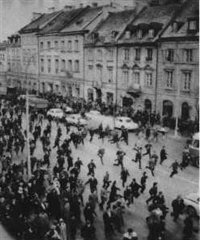
1968 was not just a year of protest in the West or in Prague - in March in Poland a protest over a banned play would unleash baton-wielding militia against students and a communist inspired anti-Semitic purge.
Representatives of university authorities and students placed flowers today at the plaque commemorating the student revolt which led to the arrest of 1, 200 students in Warsaw alone.
Forty two years ago, a wave of student demonstrations began in Poland with a mass rally at Warsaw University. The students were attacked by police reservists and street rioting broke out, spreading to most Polish universities in the coming weeks.
The Warsaw demonstration was in protest against the communist authorities’ decision to close down a production of the patriotic poetic drama Forefathers Eve by the Romantic-era writer Adam Mickiewicz at the National Theatre because of the audience’s passionate applause at passages taunting Russian power.
The March student revolt was a catalyst for an internal struggle for power within the communist party, one faction of which launched an anti-Semitic campaign under the slogan of “anti-Zionism”, following the Six Day War between Israel and Soviet-backed Arab forces the year before.
Over 15, 000 people of Jewish origin were forced out of the country. Just 5,000 Jews were left inside Poland.
The Shalom Foundation organized a gathering, Monday, at the Gdański Railway Station in Warsaw, from which most were departed abroad, with Vienna being their first destination point.
Many of the leaders of the student protests of 1968, such as the late Jacek Kuron, went on to become prominent in the Solidarity trade union of 12 years later.www.thenews.pl/national/artykul127049_remembering-march-1968-protests-in-poland.htmlComments
* Polka 08.03.2010 19:16 Poland-antisemitic country....
Over 15,000 people of the Jewish origin were forced to leave Poland in 1968. Polka
* ^^ 08.03.2010 20:22 What retarded comment written above, I read your comment on another story so I'm guessing this isn't the real Polka. In case you don't realize Poland was occupied by Russia whoever you are. ^^
* re comment 08.03.2010 22:19 It's definitely the real Polka. re comment
* Mama Mia 08.03.2010 23:05 I'm glad there are not so many Jews left in Poland nowadays.That's simple: no Jews - no antisemitism. Mama Mia
* Jasiek 09.03.2010 01:57 They have only been either converted to a non-Judaist faith or became secular at some past generations. All you four may be at least partly of the Jewish ancestry and maybe you don’t know the fact. It is ridiculous to divide Judaistic Poles from the other ones. Ultra-Orthodox Judaists may do as ultra-Catholics do, but it is no more than a fuss between extremists versus extremists. Each of you Poles exists in this world thanks to your Jewish ancestors as well as the other ones. And the above article suggests that a political opponent to the Enlightenment is always stirring up an uncultured bunch of Poles into anti-Semitism, which is, naturally, a profanatory to your own family. A sin. Jasiek
* Jasiek 09.03.2010 02:00 PS Pope John Paul II called Jews "our elder brothers". Jasiek
* Art 09.03.2010 05:28 For centuries Polish lands were a haven for Jews persecuted in the west. Art
* VN 09.03.2010 12:56 Where are these cruel milicjantów now? They must have addresses, phone numbers, email addresses...
Cut their pensions off without a single groszy, I say! Justice like this is unlikely to happen, though. VN
* Jasiek 09.03.2010 14:52 VN,
In 1989 Poles alone chose not a revolution but a round-table solution - a road of compromise and pardon.
Some Poles do not understand it indeed, but whether or not they had known the meaning of their choice they decided to choose the latter and take all the eventual responsibilities by themselves. Being a non-Polish origin myself, I admire Poles because of this choice. Couldn't be more beautiful. Jasiek
* Jasiek 09.03.2010 14:52 VN,
In 1989 Poles alone chose not a revolution but a round-table solution - a road of compromise and pardon.
Some Poles do not understand it indeed, but whether or not they had known the meaning of their choice they decided to choose the latter and take all the eventual responsibilities by themselves. Being a non-Polish origin myself, I admire Poles because of this choice. Couldn't be more beautiful. Jasiek
|
|
|
|
Post by Bonobo on Apr 11, 2010 22:04:30 GMT 1
Popieluszko’s remains exhumed
08.04.2010 10:40
The body of Father Jerzy Popieluszko, the Solidarity chaplain murdered by communist Secret Service in 1984, was exhumed, Wednesday.
The exhumation was performed in order to collect fragments of the priest’s bones as relics as part of the process of turning the Solidarity priest into a saint.
After the exhumation the remains of Father Popieluszko were laid in a tomb at St. Stanislaw Kostka church in Warsaw, where they previously rested and where they will remain even after the priest’s beatification on the 6 June, the first major stage in becoming a saint.
“The Church glorifies the saints but at the same time takes care of their earthly remains and relics,” said Szczepan T. Kraskiewicz from the Congregation for the Causes of Saints.
Jerzy Popiełuszko was abducted, tortured and murdered in October 1984 by communist functionaries. Fr. Jerzy was considered a martyr for the faith already at the time of his death, and was frequently mentioned as such by Pope John Paul II.www.thenews.pl/national/artykul129002_popieluszkos-remains-exhumed-.html
|
|
|
|
Post by Bonobo on Jul 28, 2010 21:43:48 GMT 1
Grzegorz Przemyk Birth: 1964 Death: May 14, 1983 Son of a poet Barbara Sadowska. They both were opposition activists. He was arrested on Swietojanska street in Warsaw while celebrating with three friends his high school final exams . Beaten with cruelty by two police officers he died in hospital on 14th May 1983. This murder shocked all Poland. His funeral became a big demonstration against communist government. An old article More opposition to Jaruzelski"Every death is painful, but this one is especially brutal. It will not be forgotten." As the telegram from Lech Walesa, founder of the outlawed independent trade union Solidarity, was read, a hush fell over the mourners who had gathered in Warsaw's St. Stanislaw Kostka Roman Catholic Church last week. Then they burst into applause. The funeral was for Grzegorz Przemyk, 19, a high school senior who died of injuries received from a severe beating by Polish militiamen. His death quickly became a rallying cause for Poles who hate the regime of General Wojciech Jaruzelski.
In one of the largest public gatherings since martial law was imposed 17 months ago, nearly 60,000 people thronged the church for the funeral services and joined in the hour-long procession to the cemetery. Fastened to the front of the casket was a red-and-white Solidarity banner. At the graveside, mourners tossed flowers on the casket and then raised their fingers in the V sign that has become the symbol of Polish resistance to authorities. Many wiped away tears as Przemyk's teacher declared: "Greg, I regret that I didn't have time to prepare you for the brutality of life before it struck you in such a cruel way."www.time.com/time/magazine/article/0,9171,925996-1,00.html Obituaries   Funeral 
Former communist policeman to escape justice?
28.07.2010 09:26
A former communist-era riot police officer, accused of beating a student to death in Warsaw in 1983, will probably escape justice as his case has now officially expired.
Ireneusz Kościuk was one of the officers accused of killing 19-year-old Grzegorz Przemyk, son of a well known opposition activist and poet Barbara Sadowska in 1983. The high school graduate was detained by communist police and battered to death at the police headquarters, it has been alleged.
The Supreme Court has now overturned an appeal for cassation of a verdict which declared the murder case to be discontinued due to expiration.
“It’s a failure of the Polish legal system,” said Judge Małgorzata Gierszon.
Investigations carried out before the fall of the communist regime in 1989 failed to result in administering punishment on the individuals responsible for the crime. In 1984, the suspects were acquitted while the court sentenced innocent paramedics, charged with negligence allegedly leading to the young man’s demise.
The case returned before the courts in 1989. The last in a series of trials, resulted in an eight-year imprisonment sentence for Ireneusz Kościuk. The verdict was overturned by the Appeal Court in Warsaw, which ruled the crime expired.
The alleged murder committed by Ireneusz Kościuk was a a crime under the communist regime and as such has no expiry date, claims former prosecutor general and justice minister Krzysztof Kwiatkowski, who had filed the appeal. www.thenews.pl/national/artykul136570_former-communist-policeman-to-escape-justice.html |
|
|
|
Post by Bonobo on Aug 24, 2010 21:27:56 GMT 1
Polish human torch protester monument unveiled in Prague
20.08.2010 11:15
Moment of protest. photo: IPN
A monument to Ryszard Siwiec, who burnt himself to death in Warsaw in protest against the Soviet-led invasion of Czechoslovakia in 1968, is being unveiled today in Prague.
Made of black marble, the monument is over two metres high, has inscriptions in Polish, Czech and English and stands in front of the Institute of Studies into Totalitarian Regimes.
The unveiling ceremony is being attended by the deputy prime minister of the Czech Republic Radek John and the deputy speaker of e Polish Senate Zbigniew Romaszewski.
A graduate of Lviv University, Ryszard Siwiec was a staunch anti-communist. He set himself ablaze on 8 September 1968 during a national harvest festival at a Warsaw sports stadium and died in hospital four days later. He was 59 years- old at the time and married with five children.
Siwiec’s self-immolation was witnessed by many of the 100,000 people attending the harvest festival, including Polish communist party officials and foreign diplomats, but there was no mention of his protest in the official media at the time.
Poles learnt about Siwiec’s protest as late as April 1969 from Radio Free Europe broadcasts.
Ryszard Siwiec posthumously received high state distinctions in Poland, the Czech Republic and Slovakia. A film about him, Hear My Cry, by Poland’s Maciej Drygas, won the European Film Award for Best Documentary in 1991.  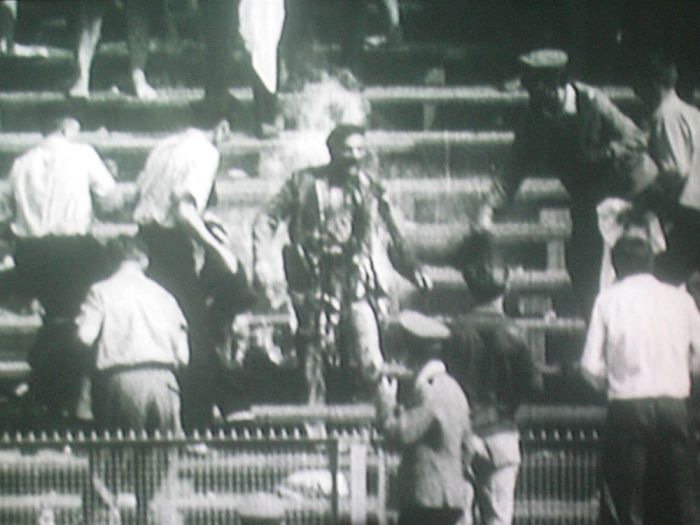 Siwiec Street in Prague
|
|
|
|
Post by Bonobo on Dec 17, 2010 23:51:39 GMT 1
President Komorowski attended a 40th anniversary ceremony in Gdynia, Thursday, in memory of those who died in the 1970 protests against communist authorities.
The day was also marked by a special showing of the new feature film Black Thursday, dedicated to the workers' revolt on the Polish coast in December 1970 which was brutally crushed by communist militia.
The film looks at the workers revolt of forty years ago through the story of shipyard worker Brunon Drywa, one of the 44 fatalities in the protests and in which another 1160 people were wounded.
Drywa’s widow was among the audience at the screening.
Directed by Antoni Krauze, Black Thursday is one of the biggest Polish film productions of recent years, with a cast including over 100 actors and some 500 extras.
The title is a reference to the events of Thursday, 17 December 1970, when the morning shift of the Paris Commune shipyard in Gdynia poured off the train to go to work and met a blast of gunfire. Thirteen people were killed.
The film’s gala premiere is to be held in Warsaw in the middle of February.
Earlier, President Komorowski gave a speech by the monument to fallen workers in Gdynia.
President Komorowski said that the workers did not die in vain, and contributed to the rebirth of a free and democratic Poland.
Komorowski also said that the prayer "Our Father, forgive us our trespasses as we forgive others who trespass against us," is a simply prayer but also one of the hardest to observe.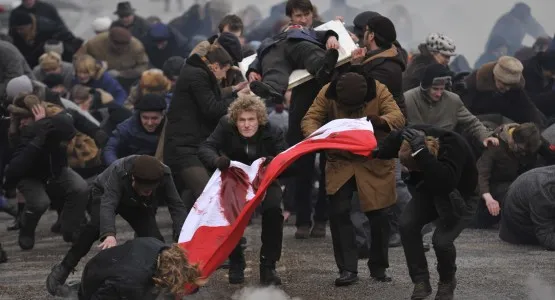 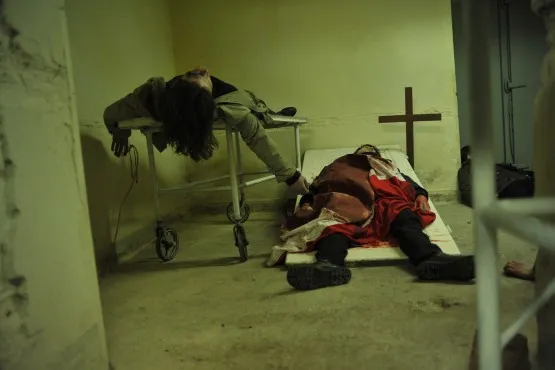 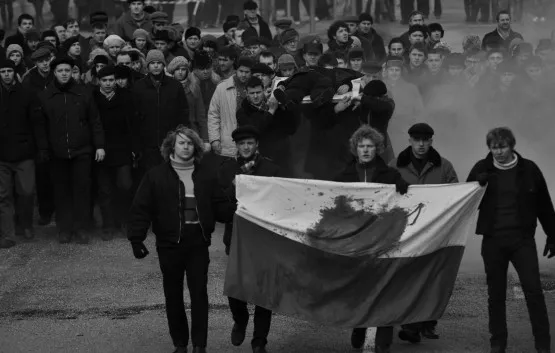            
|
|
|
|
Post by Bonobo on Dec 19, 2010 1:24:36 GMT 1
|
|
|
|
Post by Bonobo on Feb 23, 2011 1:04:09 GMT 1
Those were exciting times. I was a student in mid 1980s. In 1988 we went on strike. 1981-2011 - echoes of student union victory
17.02.2011 07:39
Thirty years ago today, Poland's communist government relented and registered the Independent Students' Union (NZS), a branch of the Solidarity movement which included many activists who are now in government.
Besides Prime Minister Donald Tusk, current ministers Bogdan Zdrojewski, Bogdan Klich and Waldemar Pawlak were also active in the first independent student union in communist Poland.
The seeds for the organisation had been sown in Gdansk in conjunction with the seminal strike at the Lenin shipyards.
On August 27 1980, a group of students, among them today's prime minister Donald Tusk and author Pawel Huelle, gathered outside the shipyards to appeal for a free student union.
The following month, representatives of dissident students from across the country met at Warsaw's Polytechnic, to advance their programme.
The enterprise was conceived in direct opposition to the official Polish Students Association (ZSP), which was considered a finishing school for aspiring communist functionaries.
On 13 November, an application was submitted to register the union, but it was rejected. A wave of strikes followed at colleges across the country, with students barricading themselves in buildings, and taking to the streets with placards. Approximately 34,000 people took part in the demonstrations.
The union was eventually registered on February 17th 1981, but it was banned following the coming of martial law in December of the same year.
NZS was reactivated following the collapse of the Iron Curtain, and it is now the main independent students' body in Poland. www.thenews.pl/national/artykul149524_1981-2011---echoes-of-student-union-victory-.html  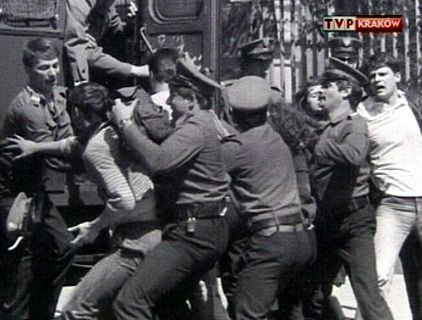      We were born in 1968   A rhyme: Commies, clean toilets!  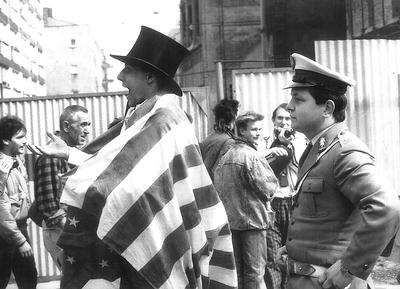   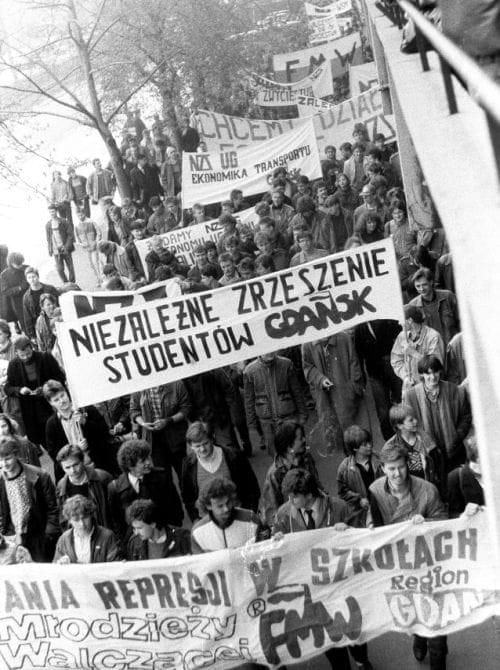 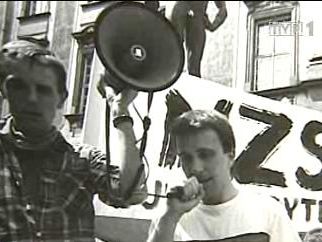 www.nzs.ajd.czest.pl/uploads/images/NZS%20WSP-%2089%5C%27.jpg www.nzs.ajd.czest.pl/uploads/images/NZS%20WSP-%2089%5C%27.jpgStrike www.wszechnica.solidarnosc.org.pl/?page_id=16182 |
|
|
|
Post by valpomike on Feb 23, 2011 16:02:35 GMT 1
And all this action, worked to make a better Poland.
Mike
|
|
|
|
Post by Bonobo on Apr 21, 2011 18:48:32 GMT 1
Ex-communist leader to land behind bars?
20.04.2011 13:29
General Czeslaw Kiszczak, Poland’s Interior Minister during Martial Law, may be handed a two-year suspended sentence for a perod of five years due to his role in the quashing of the Wujek miners’ strike in 1981, in which nine workers died.
“The accused was conscious of the fact that during Martial Law there could have been social unrest on a wide scale,” Zbigniew Zieba from the Warsaw Dicstrict Court told journalists, Tuesday.
“[Kiszczak] allowed militia functionaries to use firearms, which points to the premeditation of his decisions,” Zieba continued.
The sentence comes as Kiszczak has already been through four court cases which have lasted for a combined total of 17 years. However, an appeal to the prosecutor’s decision is likely to be lodged, sources say.
According to prosecutors in the southern city of Katowice, where the Wujek coal mine is located, Kiszczak intentionally caused “widespread danger for the life and health of people” when he sent a cable to militia units on 13 December to pacify the striking miners.
The Katowice prosecution also claims that General Kiszczak gave the green light for the militia authorities to use weapons. As a result, paramilitary ZOMO units fired shots at the miners on 15 and 16 December at the Wujek and Manifest Lipcowy mines, killing nine.
Meanwhile, Czeslaw Kiszczak, who is now 85, is professing his innocence in the matter. According to him, there is no correlation between the cable and the tragic events of December 1981.
Kiszczak maintains that the cable was a reminder of the introduction of Martial Law, although the Constitutional Tribunal recently declared that the move to impose Martial Law was in fact illegal.
The motion for the defence is to take to the floor on 26 April, after which prosecutors are expected to pass their final verdict in the case.
|
|
|
|
Post by Bonobo on Apr 21, 2011 22:58:18 GMT 1
Ryszard Kowalczyk (born 20 February 1937) and his younger brother Jerzy Kowalczyk (born 1942) - Polish brothers who planted a bomb as a protest against the communist rule in Poland.
The Kowalczyk brothers were scientists at Opole University. They planted a bomb there on 6 October 1971 as a protest specifically against the violence perpetrated by the communist authorities against the workers' protest. A big celebration for the Służba Bezpieczeństwa and Milicja Obywatelska was to take place at the University in the morning of the following day. The big explosion literally destroyed the big university hall where the celebrations were to take place.
Although no-one was injured, a wide investigation has been launched and the Kowalczyks were quickly captured. On 8 September 1972 the court in Opole sentenced Jerzy to death and Ryszard as his helper to 25 years in prison. The sentence was confirmed by the Supreme Court on 18 December 1972. Such severe sentences resulted in protests involving Jan Józef Szczepański, Wisława Szymborska, Jerzy Szacki, Stanisław Lem, Daniel Olbrychski and Catholic authorities. On 19 January 1973 the Council of State reduced Jerzy Kowalczyk's sentence to 25 years in prison.
With the rise of Solidarity in the 1980s, pardons were issued and the brothers were freed for good behavior: Ryszard in 1983 and Jerzy in 1985. In 1991 President Lech Wałęsa decided that their sentences were legally forgotten which would allow them to work again. Still this declaration and following it legal procedure, has not been confirmed by the Supreme Court, which in January 2002 ruled that the conviction of the Kowalczyks can not be appealed, justifying it mainly but not uniquely by the reasons of the legal procedure. The ruling closes the appeal possibilities in this case.  
|
|
|
|
Post by Bonobo on Jun 19, 2011 7:53:32 GMT 1
Waldemar "Major" Fydrych (born April 8, 1953) is a Polish activist best known as the founder and leader of the Orange Alternative movement in Poland. He has been recognized worldwide for his numerous cultural actions and publications.

Early career
Fydrych was born in Toruñ, Poland on April 8, 1953. He is a graduate of the History and History of Art Faculty of the University of Wroclaw. Fydrych began his independent public activity in the 1970s. He created in Wroc³aw a branch of the Independent Students Union (NZS) and launched the Movement for New Culture in the city. At this time, he was also one of the co-organizers of a massive peace march that took place in April 1981.
During the Martial Law, many Poles first made acquaintance with Fydrych's work through his picturesque dwarf images painted on building walls, covering up the paint that was used to cover up anti-regime slogans.
The Orange Alternative
Starting in 1986, he began organizing an endless chain of happenings, which were eventually named the "Orange Alternative." In March 1988, after distributing women's hygienic napkins on the street (an item missing then), he was arrested and sentenced by the Court of Justice to three months of imprisonment. He was released following general public uproar.
Nickname
At the time of the communist regime, when Fydrych was called upon to fulfill his military service obligation, he appeared before the army commission dressed in a uniform of a major. Unwilling to enter the army, he pretended the opposite, simulating madness. Asked to keep a different language in regard to his superiors, Fydrych began to address his interlocutor per "colonel," at the same time describing himself as a "major," a nickname which remained with him ever since. Orange Alternative (Pomarañczowa Alternatywa) is a name for an underground protest movement which was started in Wroc³aw, a town in south-west Poland and led by Waldemar Fydrych (sometimes misspelled as Frydrych), commonly known as Major (Commander of the Festung Breslau) in the 1980s.[1] Its main purpose was to offer a wider group of citizens an alternative way of opposition against the authoritarian regime by means of a peaceful protest that used absurd and nonsensical elements. By doing this, Orange Alternative participants could not be arrested by the police for opposition to the regime without the authorities becoming a laughing stock. Orange Alternative has been viewed as part of the broader Solidarity movement. Academics Dennis Bos and Marjolein t'Hart have asserted it was the most effective of all Solidarity's factions in bringing about the movement's success.[2] Initially it painted ridiculous graffiti of dwarves on paint spots covering up anti-government slogans on city walls. Afterwards, beginning with 1985 through 1990, it organized a series of more than sixty happenings in several Polish cities, including Wroc³aw, Warsaw, £ód¼, Lublin and Tomaszów Mazowiecki. It was the most picturesque element of Polish opposition to Stalinist authoritarianism. It suspended activity in 1989, but reactivated in 2001 and has been active on a small scale ever since.[3] A statue of a dwarf, dedicated to the memory of the movement, stands today on ¦widnicka Street in Wroc³aw, in the place where events took place.  Orange Alternative movement has inspired several other similar movements in authoritarian countries including Czechoslovakia and Hungary and it has also inspired and influenced the Pora and the so called Orange Revolution movement in Ukraine, which was in turn supported by Poland. Some utterances ascribed to Waldemar Fydrych: In Poland there are only three places when you can feel free: In churches, but only for the meditations, in prisons, but not everyone can go to prison, and on the streets: they are the freest places. The Western World will find out much more about the situation in Poland from hearing that I was put to jail for giving tampons to a woman, than from reading the books and articles written by other people from the opposition. Can you treat a police officer seriously, when he is asking you the question: "Why did you participate in an illegal meeting of dwarfs?" The Beginnings The beginning of the Orange Alternative are in a student movement called the Movement for New Culture created in 1980 at the University of Wroc³aw. It is in that year that Waldemar "Major" Fydrych, one of the movement's founders, proclaims the Socialist Surrealism Manifesto,[4] which becomes the ideological backbone behind a gazette known as "The Orange Alternative." Seven out of the total fifteen issues of this gazette appear during student strikes organized in November and December 1980 as part of the Solidarity upheaval. The first number is edited jointly by Major Waldemar Fydrych and Wies³aw Cupa³a (a.k.a. "Captain") simply with an idea to have fun. The editors treat the strike and the surrounding reality as forms of Art. For the ensuing numbers, the editorial committee is joined by Piotr Adamcio, known as "Lieutenant Pablo," Andrzej Dziewit and Zenon Zegarski, nicknamed "Lieutenant Zizi Top." Although its avangarde character, according to the student strike organizers, was a threat to the "higher aims of the strike", and notwithstanding attempts by the strike committee to censor it, the gazette became rapidly very popular among the students.[3] The Dwarves The last remaining Orange Alternative Dwarf on Madaliñskiego Street in Warsaw. Originally painted on the paint spot covering up the logo of another anti-communist group Solidarno¶æ Walcz±ca The first known actions of the Orange Alternative consisted of painting dwarf graffiti on spots created by the police's covering up anti-regime slogans on walls of the Polish cities. The first graffiti was painted by Major Waldemar Fydrych and Wies³aw Cupa³a on the night from the 30th to 31st of August 1982 on one of the residences in the Wroc³aw district of Biscupin and Sêpolno. Altogether more than one thousand of such graffiti were painted in the major Polish cities such as Wroc³aw, Kraków, Warsaw, £ód¼, and Gdañsk. Dwarves appearing in numbers all over Poland arose interest of both: Polish pedestrians and the militia, whose intervention led to short term arrests of the graffiti artists. During one of these incidents, Major, a detainee at a police station in £ód¼, proclaimed, in reference to the marxist and hegelian dialectics, yet another artistic manifesto and referred to his graffiti art as "dialectic painting" stating: "The Thesis is the Anti-Regime Slogan. The Anti-thesis is the Spot and the Synthesis is the Dwarf. Quantity evolves into Quality. The more Dwarves there are, the better it is."[3] [edit] Happenings What brought the Orange Alternative the biggest fame were its street happenings which it organized throughout the second half of the 1980s. These actions gained it enormous popularity among the Polish youth, who joined the movement, seeing it an alternative to the opposition style presented by the Solidarity, which they viewed as more stiff and boring. The first modest happening called the "Burning of Tubes" was organized as early as 1985 in Wroc³aw by Major Waldemar Fydrych accompanied by a small group of artists to which belonged: Krzysztof Skarbek, Piotr Petyszkowski, Andrzej G³uszek and S³awomir Monkiewicz.[3] The break-through moment came in the fall of 1987, during the Open Theatre Festival in Wroc³aw, when the Village Voice reported the Orange Alternative's action known as "Distribution of Toilet Paper" - a happening that laughed at the annoying, at the time, lack of that consumer product. After the publication of this article, the Orange Alternative became of interest to a number of Polish and foreign media. The biggest happenings however took place in the years 1987 through 1989, with the "orange" wave spilling over Poland into cities such as Warsaw, £ód¼, Lublin and Tomaszów Mazowiecki following Major Fydrych's arrest on March 8, 1988. PRECZ Z UPA£AMI (Polish) - "AWAY WITH SWELTER",if the person wearing letter 'U' shirt turns away  the text says PRECZ Z PA£AMI (Polish) - "AWAY WITH BATONS" happening in Wroc³aw, July 1988) The actions of the Orange Alternative - although its leaders and participants often expressed anarchistic viewpoints - were not inherently ideological. No serious demands were ever expressed. Rather, the slogans were surrealist in character (such as "Vivat Sorbovit" (Sorbovit being a popular soft drink at that time) or "There is no freedom without dwarves." Often they paraphrased slogans used by the Solidarity Union or the communists. Their role was to laugh at absurds and pompousness of both sides of the system and provoke to independent thinking. Their open street formula allowed all individuals to take part in the happenings. This openness drew thousands of pedestrians to participate in the group's actions. In such a way, the majority of the happenings could assemble thousands of participants, of whom many were accidental passers-by. The culmination point in the movement's history was the action organized on June 1st, 1988, known as the "Revolution of Dwarves", during which more than 10 thousand persons marched through the center of Wroc³aw wearing orange dwarf hats. The happenings usually terminated with the arrest of hundreds of participants, who did not manage to escape in time from the hands of the militia. The happeners were even able to provoke the communist militia to arrest at one point 77 Santa Clauses or, at another occasion, all people wearing anything red. For everyone of its actions, the Orange Alternative printed leaflets and posters, featuring slogans like "Every militiaman is a piece of Art" or "Citizen, help the militia, beat-up yourself."[3] Day of the Army  A dwarf       RIP toilet paper   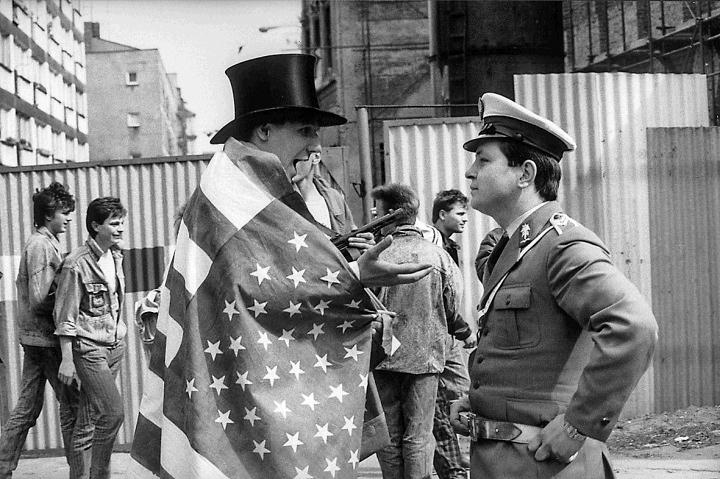 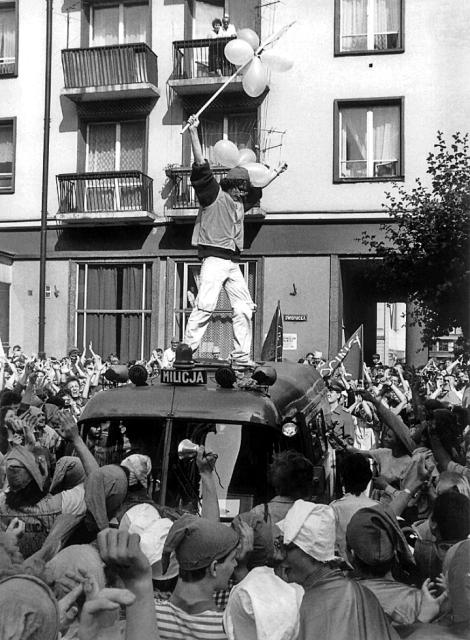    See their site www.pomaranczowa-alternatywa.org/index-eng.htmlSee the historical gallery: www.pomaranczowa-alternatywa.org/galeria3-eng.html         |
|
|
|
Post by Bonobo on Sept 27, 2011 21:34:41 GMT 1
Another wonderful example of Polish objection to communism. I didn`t talk about it too much before. Friday marks the 35th anniversary of the founding of Poland’s Workers’ Defence Committee (KOR), a precursor of Solidarity and a beacon for civil rights in 1970s
KOR was founded after a crackdown by the communist government in the summer of 1976. The announcement of a drastic increase in food prices prompted widespread unrest, leading to strikes and open rioting, above all in the south eastern city of Radom, but also in Plock and the Warsaw suburb of Ursus. Several thousand people were arrested, including many bystanders, with fines and prison sentences meted out in large numbers. Many were dismissed from work. A group of intellectuals set about trying to help the repressed and their families – focusing first on legal and financial imperatives.
On 23 September the Workers’ Defence Committee was formally established.
An appeal was sent to the government that day calling for an amnesty for all those who had been convicted or imprisoned, while those who had been dismissed from jobs would be allowed to return to work. KOR also called for full disclosure from the authorities on the measures the state had taken. Among the 14 signatories were writer Jerzy Andrzejewski, translator Stanislaw Baranczak, and the two main initiators of the action, Jacek Kuron and Antoni Macierewicz. It was not until the following year that the state began to cooperate with KOR. As it happened, the breakthrough occurred following the mysterious death of student activist Stanislaw Pyjas – who had collaborated with KOR – in May 1977. The unexplained death – which activists believed was an assassination by the security services – prompted widespread strikes and the arrest of most of the central KOR committee.
An amnesty was finally declared in July, freeing, among others, the last of the remaining workers who had been imprisoned the previous year.
KOR, which also had an underground printing press that distributed banned literature, functioned until the summer of 1981, gathering about 3,000 employees. It was partly funded by groups in the West.
With the eruption of Solidarity in Gdansk in august 1981, KOR was subsumed into the new movement. Ultimately, the main figures from KOR took part in the Round Table Talks of 1989, which ushered in democratic elections and the fall of communism.www.thenews.pl/1/9/Artykul/55628,Landmark-freedomfighting-group-remembered 1976  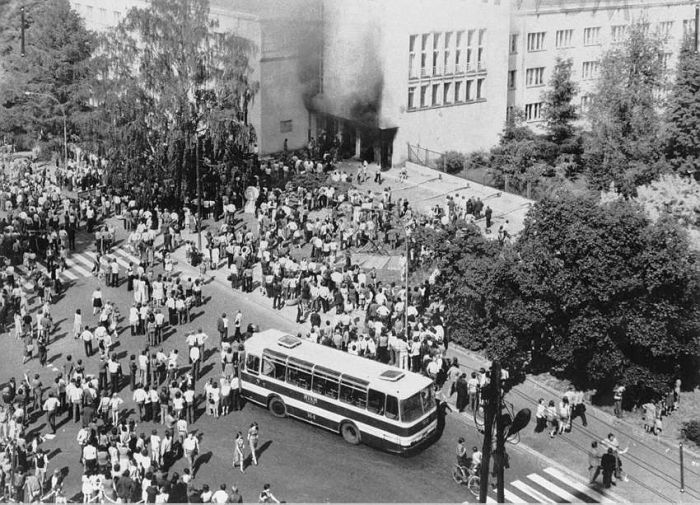 KOR meetings 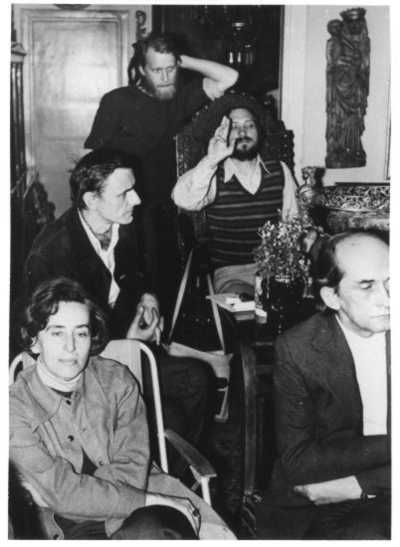   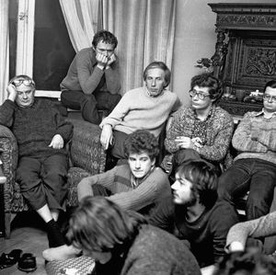 Hunger strike  |
|
|
|
Post by Bonobo on Sept 27, 2011 22:08:08 GMT 1
|
|
|
|
Post by Bonobo on Mar 11, 2012 14:03:00 GMT 1
Left avoids minute of silence to communist victims
02.03.2012 13:28
Members of the Democratic Left Alliance party (SLD) arrived late in parliament on Friday, avoiding a minute's silence for victims of post World War II repressions.
Other left-wing MPs, from both post-communist SLD and liberal Palikot's Movement (RP), “ostentatiously” walked out of the debating chamber, according to conservative MP Dawid Jackiewicz (Law and Justice).
The minute's silence came in the wake of yesterday's official day in tribute to the so-called “Cursed Soldiers.”
Now in its second year, the national tribute honours resistance fighters who opposed the communist take-over of Poland.
“Parliament wants to honour the memory of those who, led by the love of the fatherland and the idea of an independent Poland, voiced their opposition to the postwar order, often incurring the highest price,” reflected Speaker of the House Ewa Kopacz, as she announced the minute's silence.
SLD, which was largely formed from veterans of Poland's communist party, had been against the holiday, which was introduced in 2011.
“We are opposed to 1 March being a national holiday of the 'Cursed Soldiers',” SLD MP Tadeusz Iwinski told the Gazeta Wyborcza daily.
He highlighted that SLD had rejected the initial concept and that his party had hoped to find a different way of remembering the 30,000 victims of the “civil war” in Poland between 1944 and 1947.
The date of 1 March was approved by parliament as on that day in 1951, the leaders of Poland's main surviving resistance movement were executed by the communist authorities.
The so-called Freedom and Independence formation (WiN) was created after Poland's official wartime resistance movement (AK) was disbanded in January 1945.
Poland's government-in-exile in London had been obliged to dissolve the AK, owing to the official alliance between the West and the Soviet Union.
However, the 'liberation' of Poland by the Red Army saw former AK fighters rounded up by their theoretical allies.
Members of WiN were typically branded as fascists by the communist regime, and the organisation continues to inspire controversy among historians.
|
|
|
|
Post by Bonobo on Jun 18, 2016 0:19:52 GMT 1
polandsite.proboards.com/post/870
Polish Senate remembers bloody Poznań revolt of 1956
17.06.2016 11:39
The Polish Senate has paid tribute to workers in the western city of Poznań who revolted against the country’s communist rulers in 1956, leading to scores of deaths after the army opened fire on civilians.
Protest in 1956. The banner reads: "We demand bread". Photo: Wikimedia CommonsProtest in 1956. The banner reads: "We demand bread". Photo: Wikimedia Commons

In a special resolution to mark the upcoming 60th anniversary of the event, senators stressed that the revolt "began a long tide of Polish workers’ struggles with communist enslavement".
On 28 June, 1956, workers from the Cegielski engineering plant (at the time named after Soviet leader Joseph Stalin) went on strike and marched through the streets to protest against the refusal of the authorities to reduce their work quotas and raise wages.
The march turned into a huge demonstration as the city’s population joined in. In clashes that lasted two days, the security police and the army opened fire, killing at least 58 people, according to Poland’s Institute of National Remembrance. Several hundred people were wounded and some 700 arrested.
The Senate resolution recalls that “13-year-old Roman Strzałkowski – one of the first victims of the clashes – became a symbol of the heroic struggle against communist dictatorship, the nation’s enslavement and the trampling of fundamental human rights”.
It also says that the memory of the Poznań rebellion will be inseparably linked to “the sight of tanks in the streets, the threat of [the then Prime Minister] Józef Cyrankiewicz that ‘the hand raised against the people’s power will be cut off’ and the beautiful words of defence lawyer Stanisław Chejmowski that ‘one does not fire shots at people calling for bread’.”
Polish historians agree that without the Poznań revolt of 1956 there would have been no workers’ protests on the Baltic coast in December 1970 and the rise of the Solidarity movement in 1980.
|
|




































































































































































































